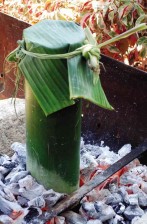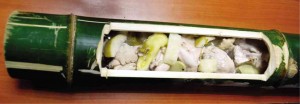Want to know more about our history? Cook ‘binakol’
The aroma of chicken binakol fills the classroom as the banana leaf cover is taken off the bamboo tube, an unlikely container in these modern times.
But the smell of the binakol by bamboo master Perry Mamaril is just a prelude to the exquisite experience of sipping its soup and chewing its meat that has been simmered in coconut juice for almost an hour in the pliable yet sturdy grass.
The sourness of guavas and kamias (bilimbi), the sweetness of half-ripe bananas and coconut meat, and the pungent taste of ginger and lemongrass are among the flavors that burst in one’s mouth. They are meant not only to satisfy gastronomical urges but also to invoke a sense of pride in an ingenious technique crafted by our Filipino ancestors and still practiced by some ethnic groups today.
Part of the binakol charm is the sugary taste of the fresh membrane lining inside the tube, Mamaril says in an interview after his cooking demo for a food-writing workshop at Enderun Colleges in Taguig City.
Sporting dreadlocks, a bandana and tattoo, the artist-chef says, “Using bamboo as a cooking vessel from time to time is a way of reviving the old tradition.”
Article continues after this advertisementCooking is learning “history at its best,” says the Baguio native Mamaril, who cooks and decorates Filipino restaurants in New York City.
Article continues after this advertisementPamana ng Pilipino awardee Amy Besa, the facilitator and main lecturer of the three-day food-writing workshop, points out: “Preservation of culinary heritage just doesn’t mean documentation. It means cooking and eating those foods again so they remain part of the people’s lives.”
Old recipes, old cooking techniques, old kitchen equipment are the key to preserving Filipino cuisine, she says.
“Flavors of food changed when they were no longer cooked in clay pots or bamboo tubes,” says Besa.
The taste of the bamboo-cooked binakol is different from the chicken that we usually eat, adds Besa, who co-owns with her husband the Purple Yam restaurant in Brooklyn, New York.
One of Besa’s advocacies is to show Filipinos that, despite 300 years of colonization, there are still many dishes and culinary practices that are ours, “that come from us.”
Beyond adobo
“Everybody thinks that they know Filipino food because they know adobo, sinigang … But there is so much more to Filipino food, so much more to learn,” said the owner of Purple Yam, a restaurant that serves Filipino dishes in New York.
In 2011, Besa formed Ang Sariling Atin (food that was always ours) Culinary Heritage Institute to preserve heirloom recipes and educate culinary students about old Philippine cooking techniques and traditional equipment as they help poor rural villages set up “community kitchens.”
“It’s an exchange of knowledge … a two-way process,” says the coauthor of “Memories of Philippine Kitchens.” “We will send culinary students, who are being trained with Western methods, to the rural areas. When the students go there, they will learn about the food in that area. In exchange, these people will learn culinary school skills such as how to fry properly and bake.”
Enderun culinary students have committed to assisting the nonprofit organization. Besa hopes to get other culinary schools to participate when they start developing more community kitchens.
“Food unites everyone,” says Besa. It is “the easiest way to share philosophy and organize people.”
The community kitchen, she says, aims to alleviate poverty in rural communities while promoting native ingredients, dishes and cooking methods.
Besa says commercially produced powders and pastes should not replace fruits and vegetables as ingredients for dishes.
“If people now prefer packaged goods than the real thing then they (fresh ingredients) will disappear. We will lose our cultural heritage,” she notes.
Slow food preferable
Bamboo artist Mamaril says if you love food, you will prefer the long and slow process.
“There is no shortcut. You can just add powder to the dish and it will be delicious but nothing beats fresh ingredients,” he says.
The Philippines is blessed with natural resources. “In the province, you can pick green mangoes and other fruits, or harvest crops from your own backyard and create a dish,” he says.
His binakol is a concoction of coconut juice and meat, guava, cassava, banana, kamias, ginger, lemongrass and garlic—a reinvention of the dish popular in Aklan, Batangas and Iloilo.
Philippine culture and history writer John Silva, who is one of the participants, says he grew up eating casserole-cooked binakol in Iloilo. Mamaril’s version of the dish has a fuller taste, Silva says. “There’s an explosion of flavors,” he says. “The cooking style also engendered a personal appreciation of our Filipino culture.”
Besa says most Philippine dishes have versions in different regions of the country.
“You can go everywhere, you find out there is so much more to learn,” she says. “And the more you learn about the food and culture, the more you’ll love your country.”
E-mail [email protected]


